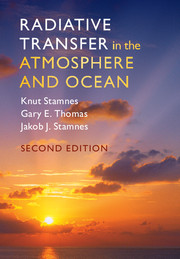Book contents
- Frontmatter
- Contents
- List of Illustrations
- List of Tables
- 1 Basic Properties of Radiation, Atmospheres, and Oceans
- 2 Basic State Variables and the Radiative Transfer Equation
- 3 Basic Scattering Processes
- 4 Absorption by Solid, Aqueous, and Gaseous Media
- 5 Principles of Radiative Transfer
- 6 Formulation of Radiative Transfer Problems
- 7 Approximate Solutions of Prototype Problems
- 8 The Role of Radiation in Climate
- 9 Accurate Numerical Solutions of Prototype Problems
- 10 Shortwave Radiative Transfer in the Atmosphere and Ocean
- Appendix A Nomenclature: Glossary of Symbols
- Appendix B Physical Constants
- Appendix C Ocean Optics Nomenclature
- Appendix D Reflectance and Transmittance at an Interface
- References
- Index
5 - Principles of Radiative Transfer
Published online by Cambridge University Press: 13 July 2017
- Frontmatter
- Contents
- List of Illustrations
- List of Tables
- 1 Basic Properties of Radiation, Atmospheres, and Oceans
- 2 Basic State Variables and the Radiative Transfer Equation
- 3 Basic Scattering Processes
- 4 Absorption by Solid, Aqueous, and Gaseous Media
- 5 Principles of Radiative Transfer
- 6 Formulation of Radiative Transfer Problems
- 7 Approximate Solutions of Prototype Problems
- 8 The Role of Radiation in Climate
- 9 Accurate Numerical Solutions of Prototype Problems
- 10 Shortwave Radiative Transfer in the Atmosphere and Ocean
- Appendix A Nomenclature: Glossary of Symbols
- Appendix B Physical Constants
- Appendix C Ocean Optics Nomenclature
- Appendix D Reflectance and Transmittance at an Interface
- References
- Index
Summary
Introduction
The radiation field in the atmosphere is affected by the presence of a bounding surface, either that of a solid land material, a water body such as an ocean or a lake, or an effective surface such as a dense cloud deck. Similarly, the radiation field in the ocean is determined by the transmission of direct and diffuse light through the ocean–atmosphere interface. In this chapter, we define emissive and reflective properties of surfaces applicable to their longwave and shortwave radiative interactions, respectively. IR surface properties are generally simpler than UV/visible properties, since reflection of IR radiation is usually unimportant. Furthermore, except at millimeter wavelengths, surfaces emit thermal radiation isotropically. Descriptions of surface interactions have historically been largely empirical, but in the past several decades, physically based models of surface reflection have gained in popularity with the need (for example) to relate land reflectance to crop yield and ocean color to water fertility. We derive a closed-form solution for the local thermodynamic equilibrium radiance for the special case of zero scattering. The formal solution for the general case then immediately follows, although since it is expressed in terms of the unknown source function, is not yet a usable result. The heating rate, photolysis rate, and dose rate are defined in terms of various integrals over the spectral radiance.
Boundary Properties of Planetary Media
A bounding surface may have up to four distinct effects on the radiation environment: (1) reflection of a portion of the incident radiation; (2) absorption of a portion of the incident radiation; (3) emission of thermal radiation, and (4) transmission of some of the incident radiation. All such processes modify the radiation field throughout the medium.
We refer to the photometric properties of surfaces when we deal with the unpolarized aspects of shortwave reflection and absorption. In the following sections, we provide mathematical descriptions of these processes in terms of quantities that relate incoming and outgoing monochromatic radiances or irradiances.
- Type
- Chapter
- Information
- Radiative Transfer in the Atmosphere and Ocean , pp. 147 - 185Publisher: Cambridge University PressPrint publication year: 2017



